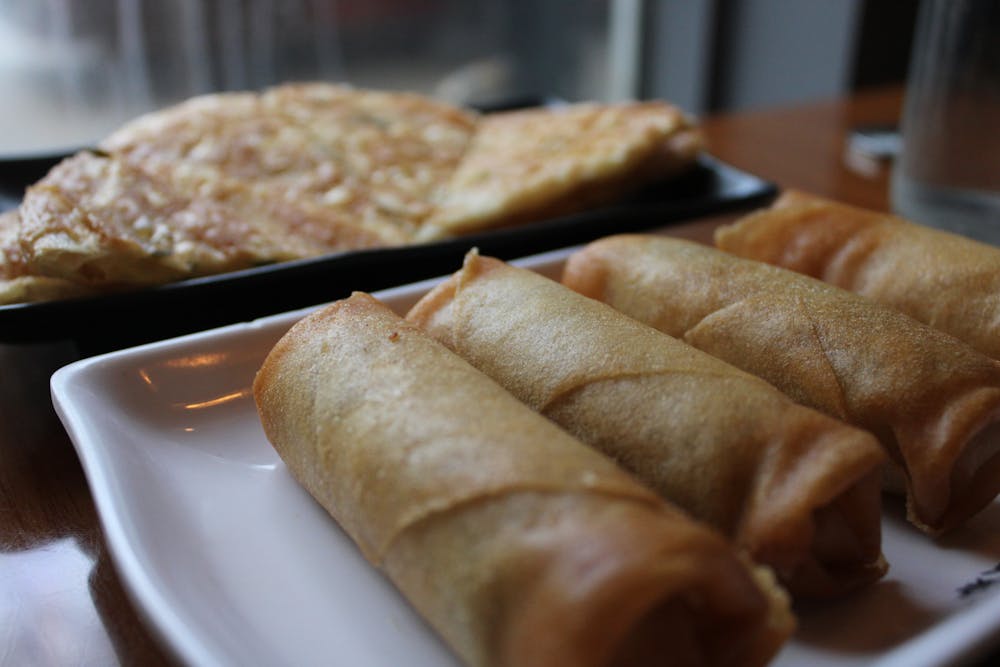McClelland Sushi and Market is the fan favorite of Penn dining halls: brisk and busy, similar to its clientele. Walking in, you’ll see students toting boxes of gyoza, bowls of udon, and trays of pork buns. One of these things is not like the other, but the systematic translation of Chinese food into American names is so normalized as to be unnoticeable. You are what you eat, and for a health–conscious America, even Chinese syllables prove to be too much of a toxin.
As Asian food rises to the forefront of the culinary world, creators and eaters are expanding their vocabulary. Foreign words from Korean, Japanese, and Vietnamese cuisine are becoming more and more commonplace. Nowadays, terms like gochujang and teriyaki are flavoring both Americans' dishes and dictionaries. However, Chinese cooking is rarely offered that same opportunity. Instead, traditional Chinese meals are being rebranded into more Western variations.
While the chop suey era of completely fabricated names is over, translation still covertly chooses which foods get to keep their native names and cultures. When Penn students meet up at Terakawa for a bowl of ramen, they will rarely say they’re craving a plate of la mian, despite the former deriving linguistically from the latter. Americans love Chinese food—but only on their own terms. We label xiao long bao as soup dumplings and mala tang as spicy hot pot. The dishes that do make it through the translation checkpoint somehow change nationalities. Take tang hulu, for example—the traditional Chinese fruit skewers covered with hard sugar recently labeled by the San Francisco Chronicle as Korean cuisine.
It’s important to note, Chinese Americans have a historical part to play in this culinary translation. In fact, many of the most Americanized dishes originated from authentic sources. Faced with immigration restrictions and strict work regulations, restaurateurs were one of the few legal professions available to early Chinese incomers. In an effort to survive amidst alienation, palatability of both cuisine and culture was required, thus giving birth to dishes like orange chicken—sweet and saccharine enough to distract from its foreignness and attract a white clientele. Like their Angel Island predecessors, many dishes had to change their names or fabricate their stories to be admitted into an American diet.
Historically, Chinese food has never been completely accepted. In 1890, a Philadelphia newspaper described the atmosphere of a Chinese restaurant as having "offensive odors" and "queer viands." A century later, modern doctors began diagnosing individuals with “Chinese Restaurant Syndrome,” a legal medical condition based on claims that MSG in Chinese food leads to headaches and nausea. Even today, you’ll find health articles discussing the high sugar, fat, and caloric content of Chinese dishes with a disparaging tone. A recent Health Digest article describes General Tso’s chicken as "a recipe for a diabetic coma."
While foreign food is still often met with derision, the modern foodie attitude is remarkably different. Asian countries have developed at a swift pace, and their cultures have begun rapidly exporting across the globe. Stateside, there is a massive demand for luxe international Chinese restaurant chains, with openings of trendy locations like Hai Di Lao, Din Tai Fung, and Tim Ho Wan.
Yet, political discrimination has not gone away, and quotas for immigrants and imports remain. Both Japan and Korea have warm relations with the United States, and thus their dishes keep their native names. The ways we refer to Chinese food are systematically different, a schema of translation that subtly denationalizes important cultural signifiers. Somehow, the tones and intonations of Mandarin and Cantonese are impossible to transfigure, while other languages remain. Referring to something in its native language is a sign of dignity and respect—the choices we make denote which cultures get to be recognized as themselves.
Like the foods we ferment, the names of our meals, too, are infused with meaning over time. Our favorite dishes absorb history from their cultural surroundings. Translation is a form of reconstruction, ripping an item from its past identity to begin a new one. These acts of Westernization are deceptive, creating an entirely new cultural significance divorced from the people who cooked these meals first.
The increased palatability of Chinese cuisine erases the efforts of generations desperately trying to forge connections to home. Flavors reconstructed from memory and recipes that have traversed continents are vital parts of a heritage that defines Asian American identities. By not acknowledging this legacy, all we’re eating is empty calories.







